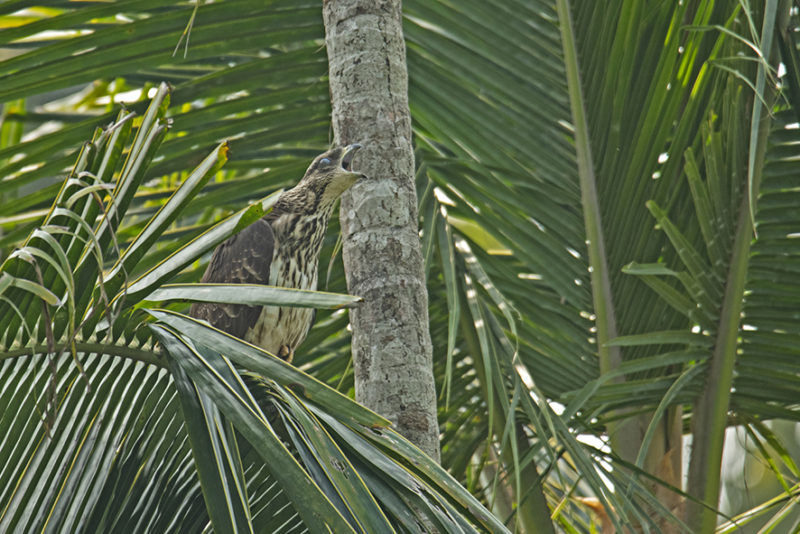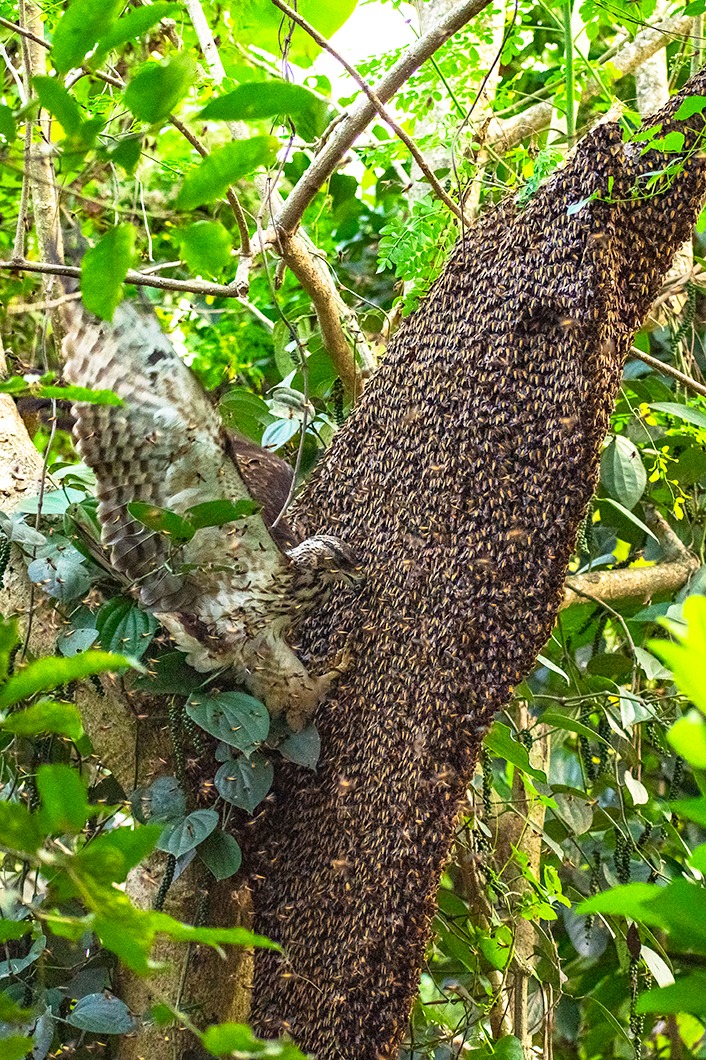The floods in the year 2018 drowned almost the entire state of Kerala. Chapters, our abode was also not spared. My small family with my husband Murali Mohan, five year old son Ishan and myself had to flee leaving back our small sanctuary to drown under the wrath of Manalipuzha. Once the flood waters receded, it took us a lot of time and hard work to put everything back together. For the first few days our usual feathered friends, our neighbourhood jungle cat and the mongoose that used to make their daily rounds never showed up. Slowly when everything was getting back to normal we too returned to our routine backyard birding. On a fine evening, we were about to leave our house and suddenly the cacophony of Yellow-billed Babblers, a pair of Ashy Drongos and squirrels stopped all of a sudden. Pin drop silence and all of them were hiding in the bushes. To our surprise a big swarm of bees flew past us.
In over a week’s time we found where the bees were flying to. It was on a Moringa tree that they had built a 30 cm big hive. This is the third time that a bee hive had been built close to home. The first was a little farther away from the house in a piece of government land and was at some point destroyed for some developmental projects. After that, the bees colonised in a large dead tree trunk behind the house. We had constantly monitored that hive. It was a reasonably large hive and one day our helper called us in agony. Scared and worried, she narrated what she had seen. A big bird was trying to break the hive and the angry bees were all over the compound. Expecting to have a glimpse of the dream that we had been wishing to see for a long time I rushed home. Luck was not in our favour this time. The stealthy Oriental Honey Buzzard had already finished with the hive by the time I reached there. We had to satisfy ourselves from the natural history knowledge that we gathered from our helper lady. But this third time, from the day we found the active hive we started monitoring the hive and the surrounding areas. Every day we scouted the area for the presence of the bee hunter. In two months’ time the hive grew 60 cm down. But the bird still did not turn up.
 It was a Sunday and after the daily chores I sat with my binoculars and camera in the veranda. Something was happening near the coconut tree. All the small birds around were alert and loud. The drongo was trying to chase something. I could not see anything initially but there was one bird call which sounded somewhat similar like the beginning of the usual call of Crested Serpent Eagle. That was a very familiar bird and I had never heard them calling like this. I got curious. I walked towards the coconut tree only to realise that I flushed the bird away. It flew and perched on another tree in the backyard. I ran to my terrace to find our most expected guest, a pale and beautiful Oriental Honey Buzzard with its trademark pigeon like head. We got excited, my husband Murali and myself started monitoring the place a bit more extensively. We were sure that the hunt will happen any time. The bird might have already started planning to dive into its favourite meal. Ishan, who was also interested like us, was forbidden to go close to the hive. Our daily dose of observation really helped. Now we knew that the moment the small birds were highly vocal,our special guest would be around. Every time there was a loud clamouring of the birds we ran out to check if it had attacked the hive. Our eagerness and patience started to get to its peak and at some point it seemed like the bird was not interested in the hive.
It was a Sunday and after the daily chores I sat with my binoculars and camera in the veranda. Something was happening near the coconut tree. All the small birds around were alert and loud. The drongo was trying to chase something. I could not see anything initially but there was one bird call which sounded somewhat similar like the beginning of the usual call of Crested Serpent Eagle. That was a very familiar bird and I had never heard them calling like this. I got curious. I walked towards the coconut tree only to realise that I flushed the bird away. It flew and perched on another tree in the backyard. I ran to my terrace to find our most expected guest, a pale and beautiful Oriental Honey Buzzard with its trademark pigeon like head. We got excited, my husband Murali and myself started monitoring the place a bit more extensively. We were sure that the hunt will happen any time. The bird might have already started planning to dive into its favourite meal. Ishan, who was also interested like us, was forbidden to go close to the hive. Our daily dose of observation really helped. Now we knew that the moment the small birds were highly vocal,our special guest would be around. Every time there was a loud clamouring of the birds we ran out to check if it had attacked the hive. Our eagerness and patience started to get to its peak and at some point it seemed like the bird was not interested in the hive.
The bees were active as usual and by December, the bee hive was over 150 cm in size. Smaller plants, bushes and creepers around it also had grown big. December 8, 2018 was a second Saturday. It was a fine morning until everything turned upside down. Our helper lady came running into the house and slammed the door immediately as she came in. ‘Close all the windows and doors!’, she shouted. The bird had hit the hive and the angry bees, in retaliation were mercilessly stinging everything that they came across. I went to my window from where we could see the hive and opened it slightly to push the lens of my camera through it. I tried my best to camouflage among the curtains and through my camera’s viewfinder I saw the Honey Buzzard perched near to the hive. The bees were still flying around madly in rage. From the information we had gathered and our own experience with the bird it normally dives down from heights or distances to pound upon the hive. In this case the hive was too low and the area was covered with creepers and bushes. So the bird was patiently waiting, observing and making a move from all sides as if it was looking for the best route to attack. All the hindrances around seemed not helping the bird in having a perfect hit. But it did attack the hive a couple of times and after several attempts it broke a piece, flew away with it and did not come back. Regardless, we were happy enough to have witnessed it, to have clicked some photos and taken some videos.
 When the commotion was over, all our joy went down when we found that our Kasargod dwarf cow was badly stung. It was lying unconscious in the field as it was attacked by the bees. Veterinary doctors were called in. It took two hours and three people to remove hundreds of stings from the cow’s body. The cow was sadly mooing all through the time. The cow was pregnant and she was nearing her delivery dates which made things even worse. Medicines were given to the cow and it was taken back to barn by night. The doctors gave a very low chance for its survival. We were very much worried as she was like a family member to us.
When the commotion was over, all our joy went down when we found that our Kasargod dwarf cow was badly stung. It was lying unconscious in the field as it was attacked by the bees. Veterinary doctors were called in. It took two hours and three people to remove hundreds of stings from the cow’s body. The cow was sadly mooing all through the time. The cow was pregnant and she was nearing her delivery dates which made things even worse. Medicines were given to the cow and it was taken back to barn by night. The doctors gave a very low chance for its survival. We were very much worried as she was like a family member to us.
The very next day, our hero showed up early morning itself and began to attack soon after. By then we had hung mosquito nets all over the barn and smoked around to protect the cows from getting stung again. Again the bird attempted couple of dives and flew away with some pieces. That day Ishaan and our neighbour also got stung by the bees, fortunately, it was just one, unlike our cow that suffered hundreds.
The following day after much effort the bird managed to break the bee hive. It took away almost all parts of the hive soon after destroying it. Bees were flying restlessly in an aggressive way all over the area. We warned our neighbours and everyone was pretty cautious not to venture outside. The ferocious bees attacked everything on their way. After a few minutes the entire swarm of bees flew away with a loud buzz towards a paddy field and never came back. Luckily with the constant support from our doctors our cow survived and gave birth to a female calf. The Oriental Honey Buzzard still visits and scouts its territory, our home, reminding us about the great experience.
